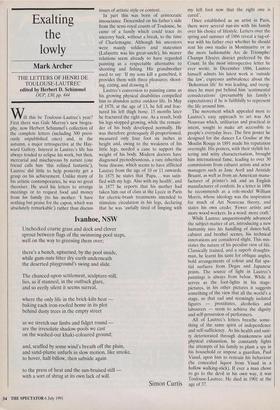Exalting the lowly
Mark Archer
THE LETTERS OF HENRI DE TOULOUSE-LAUTREC edited by Herbert D. Schimmel OUP, £30, pp. 444 Will this be Toulouse-Lautrec's year? First there was Gale Murray's new biogra- phy, now Herbert Schimmel's collection of the complete letters (including 300 previ- ously unpublished ones) and, in the autumn, a major retrospective at the Hay- ward Gallery. Interest in Lautrec's life has always tended to eclipse his work, but then, mercurial and mischievous by nature (one friend calls him 'this refined fantastic'), Lautrec did little to help posterity get a grasp on his achievement. Unlike many of his artistic contemporaries, he was no great theoriser. He used his letters to arrange meetings or to request food and money from his family (to his mother: 'I have nothing but praise for the capon, which was absolutely remarkable') rather than discuss
Issues of artistic style or content.
In part this was born of aristocratic insouciance. Descended on his father's side from the semi-royal counts of Toulouse, he came of a family which could trace its ancestry back, without a break, to the time of Charlemagne. Although his ancestors were mainly soldiers and statesmen (Lafayette was his great-uncle), his nearer relations seem already to have regarded painting as a respectable alternative to shooting and fishing. His grandmother used to say: 'If my sons kill a gamebird, it provides them with three pleasures: shoot- ing, eating, and drawing it.'
Lautrec's conversion to painting came as his growing physical disabilities compelled him to abandon active outdoor life. In May of 1878, at the age of 13, he fell and frac- tured his left thigh bone; 15 months later he fractured the right one. As a result, both his legs stopped growing, while the remain- der of his body developed normally. He was therefore grotesquely ill-proportioned, measured only four foot six inches in height and, owing to the weakness of his little legs, needed a cane to support the weight of his body. Modern doctors have diagnosed pycnodysostosis, a rare inherited bone disease, which seems to have afflicted Lautrec from the age of 10 or 11 onwards. In 1875 he states that 'Papa. . was satis- fied with my legs. Also with my health', and in 1877 he reports that his mother had taken him out of class at the Lycee in Paris for electric-brush treatments intended to stimulate circulation in his legs, declaring that he was 'awfully tired of limping with
my left foot now that the right one is cured'.
Once established as an artist in Paris, there were several run-ins with his family over his choice of lifestyle. Letters over the spring and summer of 1886 reveal a tug-of- war with his father over whether he should rent his own studio in Montmartre or in the more fashionable Arc de Triomphe/ Champs Elysees district preferred by the Count. In the most introspective letter he ever wrote, in December 1886, Lautrec himself admits his latest work is 'outside the law', expresses ambivalence about the `Bohemian life' he was leading, and recog- nises he must put behind him 'sentimental considerations' (presumably his family's expectations) if he is faithfully to represent the life around him.
The movement which appealed most to Lautrec's easy approach to art was Art Nouveau which, utilitarian and practical in intent, sought to make art accessible to people's everyday lives. The first poster he designed for the dancer La Goulue at the Moulin Rouge in 1891 made his reputation overnight. His posters, with their stylish let- tering and witty characterisation, brought him international fame, leading to over 30 commissions from cabaret artists and actor managers such as Jane Avril and Aristide Bruant, as well as from an American manu- facturer of printer's ink and an English manufacturer of confetti. In a letter in 1896 he recommends as a role-model William Morris, whose ideology was the inspiration for much of Art Nouveau theory, and states his own credo: 'Fewer artists and more wood workers. In a word: more craft.'
While Lautrec unquestionably advanced the subject-matter of art, introducing a new humanity into his handling of dance-hall, cabaret and brothel scenes, his technical innovations are considered slight. This mis- states the nature of his peculiar view of life. Classically trained, and a superb draughts- man, he learnt his taste for oblique angles, bold arrangements of colour and flat spa- tial surfaces from Degas and Japanese prints. The source of light in Lautrec's paintings is always from below. While it serves as the foot-lights in his stage- pictures, in his other pictures it suggests something of the view that all the world's a stage, so that sad and seemingly isolated figures — prostitutes, alcoholics and labourers — seem to achieve the dignity and self-possession of performers.
All of Lautrec's letters breathe some- thing of the same spirit of independence and self-sufficiency. As his health and sani- ty deteriorated through drunkenness and physical exhaustion, he constantly fights the attempts of his family to plant a spy in his household or impose a guardian, Paul Viaud, upon him to restrain his behaviour (he concealed liquor from Viaud in a hollow walking-stick). If ever a man chose to go to the devil in his own way, it was Toulouse-Lautrec. He died in 1901 at the age of 37.


















































 Previous page
Previous page